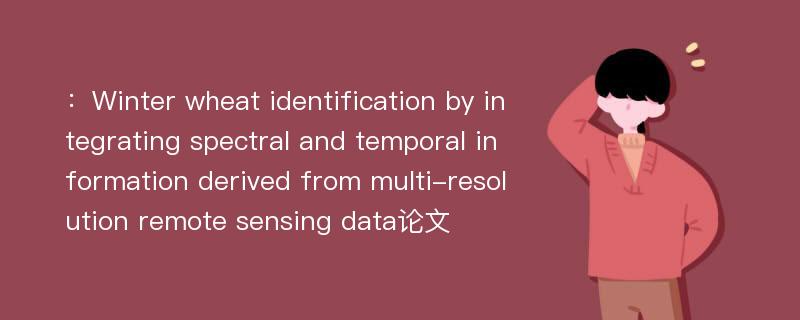
本文主要研究内容
作者(2019)在《Winter wheat identification by integrating spectral and temporal information derived from multi-resolution remote sensing data》一文中研究指出:Timely crop acreage and distribution information are the basic data which drive many agriculture related applications. For identifying crop types based on remote sensing, methods using only a single image type have significant limitations. Current research that integrates fine and coarser spatial resolution images, using techniques such as unmixing methods, regression models, and others, usually results in coarse resolution abundance without sufficient detail within pixels, and limited attention has been paid to the spatial relationship between the pixels from these two kinds of images. Here we propose a new solution to identify winter wheat by integrating spectral and temporal information derived from multi-resolution remote sensing data and determine the spatial distribution of sub-pixels within the coarse resolution pixels. Firstly, the membership of pixels which belong to winter wheat is calculated using a 25-m resolution resampled Landsat Thematic Mapper(TM) image based on the Bayesian equation. Then, the winter wheat abundance(acreage fraction in a pixel) is assessed by using a multiple regression model based on the unique temporal change features from moderate resolution imaging spectroradiometer(MODIS) time series data. Finally, winter wheat is identified by the proposed Abundance-Membership(AM) model based on the spatial relationship between the two types of pixels. Specifically, winter wheat is identified by comparing the spatially corresponding 10×10 membership pixels of each abundance pixel. In other words, this method takes advantage of the relative size of membership in a local space, rather than the absolute size in the entire study area. This method is tested in the major agricultural area of Yiluo Basin, China, and the results show that acreage accuracy(Aa) is 93.01% and sampling accuracy(As) is 91.40%. Confusion matrix shows that overall accuracy(OA) is 91.4% and the kappa coefficient(Kappa) is 0.755. These values are significantly improved compared to the traditional Maximum Likelihood classification(MLC) and Random Forest classification(RFC) which rely on spectral features. The results demonstrate that the identification accuracy can be improved by integrating spectral and temporal information. Since the identification of winter wheat is performed in the space corresponding to each MODIS pixel, the influence of differences of environmental conditions is greatly reduced. This advantage allows the proposed method to be effectively applied in other places.
Abstract
Timely crop acreage and distribution information are the basic data which drive many agriculture related applications. For identifying crop types based on remote sensing, methods using only a single image type have significant limitations. Current research that integrates fine and coarser spatial resolution images, using techniques such as unmixing methods, regression models, and others, usually results in coarse resolution abundance without sufficient detail within pixels, and limited attention has been paid to the spatial relationship between the pixels from these two kinds of images. Here we propose a new solution to identify winter wheat by integrating spectral and temporal information derived from multi-resolution remote sensing data and determine the spatial distribution of sub-pixels within the coarse resolution pixels. Firstly, the membership of pixels which belong to winter wheat is calculated using a 25-m resolution resampled Landsat Thematic Mapper(TM) image based on the Bayesian equation. Then, the winter wheat abundance(acreage fraction in a pixel) is assessed by using a multiple regression model based on the unique temporal change features from moderate resolution imaging spectroradiometer(MODIS) time series data. Finally, winter wheat is identified by the proposed Abundance-Membership(AM) model based on the spatial relationship between the two types of pixels. Specifically, winter wheat is identified by comparing the spatially corresponding 10×10 membership pixels of each abundance pixel. In other words, this method takes advantage of the relative size of membership in a local space, rather than the absolute size in the entire study area. This method is tested in the major agricultural area of Yiluo Basin, China, and the results show that acreage accuracy(Aa) is 93.01% and sampling accuracy(As) is 91.40%. Confusion matrix shows that overall accuracy(OA) is 91.4% and the kappa coefficient(Kappa) is 0.755. These values are significantly improved compared to the traditional Maximum Likelihood classification(MLC) and Random Forest classification(RFC) which rely on spectral features. The results demonstrate that the identification accuracy can be improved by integrating spectral and temporal information. Since the identification of winter wheat is performed in the space corresponding to each MODIS pixel, the influence of differences of environmental conditions is greatly reduced. This advantage allows the proposed method to be effectively applied in other places.
论文参考文献
论文详细介绍
论文作者分别是来自Journal of Integrative Agriculture的,发表于刊物Journal of Integrative Agriculture2019年11期论文,是一篇关于,Journal of Integrative Agriculture2019年11期论文的文章。本文可供学术参考使用,各位学者可以免费参考阅读下载,文章观点不代表本站观点,资料来自Journal of Integrative Agriculture2019年11期论文网站,若本站收录的文献无意侵犯了您的著作版权,请联系我们删除。
